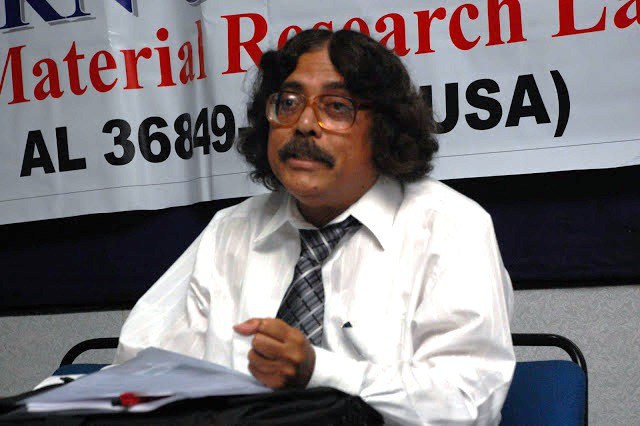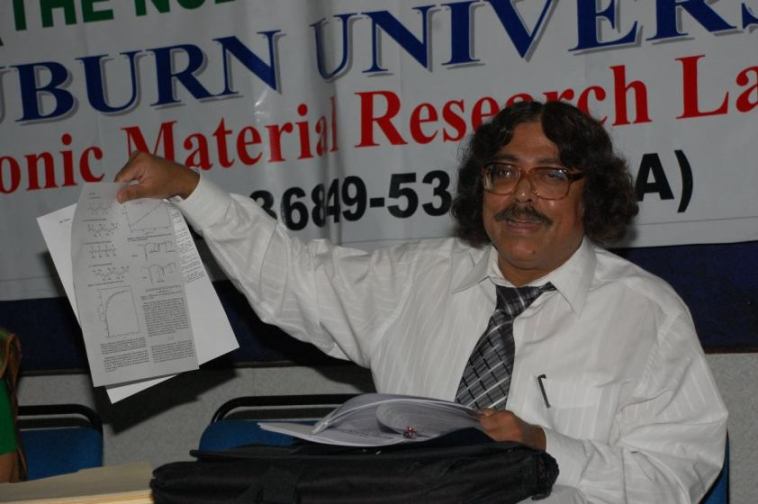Nuclear Radiation Fear, Demand for Iodine Pills Necessitates Shielding Nuclear Reactors using Novel Polymer-basedTechnology: Professor Thakur

Close on the heels of rise in demands for the potassium-iodide pills throughout the European Union (EU) following fear of damage of nuclear reactors due to the Ukraine-Russia war, the need for sealing the nuclear power reactors with novelpolymer-based technology has become urgent.
Observing this, Professor Mrinal Thakur, the Director of Photonic Materials Research Laboratory of Auburn University in the USA who discovered the “Nonconjugated Conductive Polymers” has warned that it is time adopt protective measures or suffer consequences.
In a statement here, Professor Thakur who has been nominated for the Nobel Prize in Chemistry for 20 times deplored that protection of nuclear power generation facilities using his invention has remained long past due. He has requested the Royal Swedish Academy of Sciences (RSAS) to accord due recognition to his discovery of the “Nonconjugated Conductive Polymers.”
As it appears in the website of The Nobel Foundation,“A key property of a conductive polymer is the presence of conjugated double bonds along the backbone of the polymer. In conjugation, the bonds between the carbon atoms are alternately single and double.” Also, “For a polymer to be able to conduct electric current it must consist alternately of single and double bonds between carbon atoms”.These fundamental statementsare nonfactual / incorrect since these disregard existence of “Nonconjugated” Conductive Polymers and their impact.
The Nobel Foundation is in tacit agreement with Professor Thakur. The Indian Press stressed that the Foundation should take immediate action to acknowledge and provide credit to Professor Thakur since it has been a long overdue.
The Indian Press warned that there is deep public discontent over the following critical issueswhich have remained unaddressed:
- No credit was given to Professor Thakur in 2000 Nobel Prize and afterwards for his discovery of “Nonconjugated Conductive Polymers.”
- Royal Swedish Academy is yet to correct the document preserved at the Nobel Foundation website despite repeated requests. The document states a polymer must be conjugated to be electrically conductive – which is nonfactual and the corresponding theory as given is incorrect.
- Professor Thakur’s research funding was abruptly stopped in 2003 as he brought up the incorrectness and inequity regarding the 2000 Nobel Prize in Chemistry.
- Professor Thakur stakes claim to the 2014 Nobel Prize in Chemistry as well since “Super-resolved Fluorescence Microscopy” (2014 Nobel in Chemistry)is primarily based on earlier nonlinear optical experimental and theoretical studies performed by Professor Thakur and colleagues on organic materials.
Providing protection against nuclear radiation including radioactive iodine is one of the major applications of nonconjugated conductive polymers. Radioactive iodine is particularly dangerous since it remains as a vapor at ordinary temperature and can travel long distances over a very short time. It causes thyroid cancer and various other ailments. Applying the polymer shields around the nuclear reactors (standard and modular) is of critical need to protect lives and the environment – said Professor Thakur.The nuclear waste facilities which store spent nuclear fuel rods must also be insulated using this polymer technology.

Professor Thakur did not receive credit in the 2000 Nobel Prize. Again in 2014, the Nobel Committee did not give him credit for his equation and the underlying fundamental experimental and theoretical works in nonlinear optics that were critical for super-resolved fluorescence microscopy!
Scientific Explanation of Thakur’s Equation
The 2014 Nobel Prize in Chemistry was awarded to Betzig, Hell and Moerner for their works on “Super-Resolved Fluorescence Microscopy.”
The central equation used in this work is based on nonlinear optics works and phase-space-filling model developed by Professor Thakur and coworkers. No reference of that is given in the 2014 Nobel document preserved at the Nobel Foundation website.
Detailed nonlinear optical coefficients as a function of wavelength, excited-state lifetimes, two-photon absorption and the detailed saturation dynamics have all been measured by Professor Thakur and coworkers using femtosecond-duration pulses and their theoretical interpretations have been established.The excited state lifetime as measured is about 1.8 ps. In the off-resonant domain the response is instantaneous.
As discussed in such reports, (phase-space filling model applied to PTS-polydiacetylene crystal), the fractional change in oscillator strength, δf/f is related to the number fraction of electrons (excitons) involved in the transitions is as given in the following:δf/f = – N/Nswhere Ns is the saturation density.
For organic materials, energy levels remain essentially unchanged when light is incident on it. Using the phase-space filling model as above verified by detailed experimental measurements (Thakur et al. 1985-88), the equation relating the resolution and laser light intensity (Thakur’s Equation) that one arrives at isΔ = λ/(2nsinα(1 + I/Is)1/2). HereΔ stands for resolution, I stands for laser light intensity, λ is wavelength, n is refractive index,α is semi-aperture angle and Isis saturation intensity. More details of the equation have recently appeared (Thakur, J. Macromol. Sci., PAC 2016 and references therein).
This is the central equation, Equation 3 given in page 5 of the 2014 Nobel document preserved at the Nobel Foundation website and is derived based on phase-space filling model and the statistics involved in the emission process. No reference for this equation was provided in that document.Professor Thakur received no credit in 2014 Nobel Prize!





